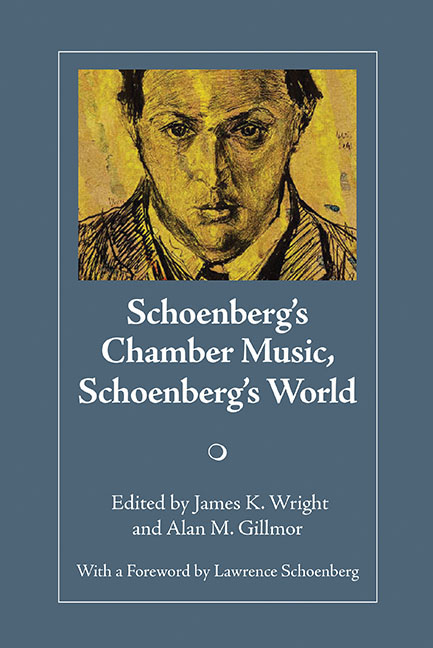Book contents
- Frontmatter
- Contents
- Foreword
- Preface
- HISTORICAL PERSPECTIVES
- The Young Arnold Schoenberg
- Schoenberg's String Quartet No. 1 in Dresden (1907): Programming the Unprogrammable, Performing the Unperformable
- A Bridge to a New Life: Waltzes in Schoenberg's Chamber Music
- The “Popular Effect” in Schoenberg's Serenade, Op. 24
- ANALYTICAL PERSPECTIVES
- OTTAWA SYMPOSIUM AND CHAMBER MUSIC FESTIVAL PHOTOS
- PERFORMANCE, RECEPTION, AND INTERNATIONAL INFLUENCE
The “Popular Effect” in Schoenberg's Serenade, Op. 24
from HISTORICAL PERSPECTIVES
- Frontmatter
- Contents
- Foreword
- Preface
- HISTORICAL PERSPECTIVES
- The Young Arnold Schoenberg
- Schoenberg's String Quartet No. 1 in Dresden (1907): Programming the Unprogrammable, Performing the Unperformable
- A Bridge to a New Life: Waltzes in Schoenberg's Chamber Music
- The “Popular Effect” in Schoenberg's Serenade, Op. 24
- ANALYTICAL PERSPECTIVES
- OTTAWA SYMPOSIUM AND CHAMBER MUSIC FESTIVAL PHOTOS
- PERFORMANCE, RECEPTION, AND INTERNATIONAL INFLUENCE
Summary
In his Notes to Literature, Theodor W. Adorno discussed the unusual syntax of Friedrich Hölderlin's late poetry, drawing particular attention to the poet's propensity for juxtaposing propositions without the use of a connective. This linguistic device, whereby the relationship between clauses is not indicated, is called parataxis. Although we might consider a literary style that relies on simple copulatives—such as “and” or “namely”—as primitive or inelegant, Adorno argued that “the function of language in Hölderlin qualitatively outweighs the usual function of poetic language,” and cautioned that parataxis is exploited by Hölderlin for expressive purposes, mirroring, and reinforcing, in the text of “Brot und Wein,” for instance, feelings of remoteness and alienation.
Schoenberg, in his invocation of parataxis, undoubtedly had similar expressive concerns, yet, at the same time, it represented a way out of an impasse.
In his 1925 essay “Tonality and Form,” a tirade against his fellow-composers, he likened the structure of contemporary composition to the “primitive art of presenting thoughts” in prose (“And then I said … and then he said … and then we laughed … and … and so on”), contending that the paratactic organization of the art work via an orderly succession of ideas was markedly different from the “complex structure and treatment” and “clearly woven threads” of a novel by Dickens. A similar distinction was drawn in his essay “Folkloristic Symphonies” of 1947 between the musical analogues of parataxis and its antithesis, hypotaxis. In relation to the former he wrote:
Structurally, there never remains in popular tunes an unsolved problem, the consequences of which will show up only later. The segments of which it consists do not need much of a connective; they can be added by juxtaposition, because of the absence of variance in them. There is nothing in them that asks for expansion. The small form holds the contents firmly, constituting thus a small expansion but an independent structure.
Given Adorno's description of the parataxes in Hölderlin's poetry as “artificial disturbances that evade the logical hierarchy of a subordinating syntax,” the kinship between the formal structure of a popular tune and parataxis in literature is suggested not only by the accretion of segments without the use of a connective or copula, but also by the absence of a hierarchy between individual segments.
- Type
- Chapter
- Information
- Schoenberg's Chamber Music, Schoenberg's World , pp. 37 - 52Publisher: Boydell & BrewerPrint publication year: 2009
- 1
- Cited by

